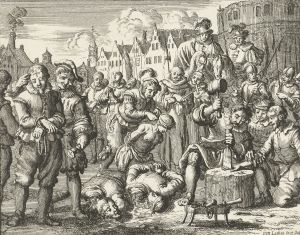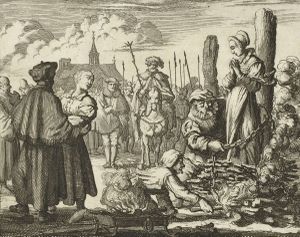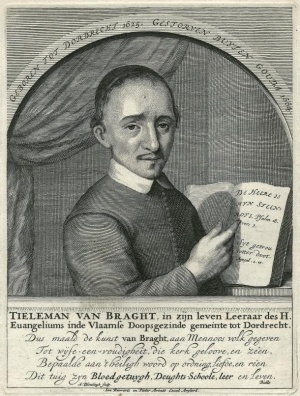Martyrs' Mirror
In 1660 a stately volume of 1290 pages appeared, entitled Het Bloedig Tooneel Der Doops-gesinde, En Weereloose Christenen. Die/om het getuygenisse Jesu hares Salighmaeckers/geleden hebben/en gedoodt zijn/van Christi tijdt af/tot dese onse laetste tijden toe. Mitsgaders, Een beschrijvinge der H. Doops, ende andere stucken van den Godsdienst, door alle de selve geoeffent. Begrepen in Twee Boecken. Zijnde een vergrootinge van den voorgaenden Martelaers-Spiegel, uyt vele geloofweerdige Chronijcken/Memorien/Getuygenissen/etc. Door T. J. V. B. Gedruckt tot Dordrecht, by Jacob Braat, Voor Jacobus Savry, woonende in 'I Kasteel van Gendt. In 't Jaer 1660. The author was Tieleman Jansz van Braght, the elder of the Flemish Mennonite congregation at Dordrecht. The preface of the book is signed "Dordrecht July 23, 1659." The Introduction contains in succession (1) a note of the printers to the readers; (2) a note of van Braght to his "dear friends and companions in Jesus Christ, our Saviour"; (3) a general address to the readers; (4) a short summary of the book; (5) a treatise, "The true church of God and its origin, expansion and immovable stability through all centuries" -- in this section are found the three major confessions of the Dutch Mennonites; viz., the Olyftacxken of 1627, that of Jan Cents of 1630, and the Dordrecht Confession of 1632; (6) a treatise concerning the ungodly and false church; (7) a laudatory poem by Cornelis van Braght, entitled "Martyrs' crown for Jesus Christ the Saviour and those nonresistant crossbearers who follow in his train."
Van Braght's martyr book, usually called in Dutch the Martelaersspiegel, i.e., Martyrs' mirror (this word actually appears first in the second edition, 1685) is divided into two parts. Part 1, containing 450 pages, followed by an index, deals with Christian martyrdom from the time of Christ to 1500, although in its last chapter (pp. 397-408) a number of later martyrs are found, who like Christian Gasteyger and Thomas van Imbroek, whose confession is inserted here, suffered because of their rejection of infant baptism. Part I concludes with a "confession of, faith according to the Holy Word of God" in 33 articles. Part II (840 pp.) contains (1) Preface, (2) Introduction, and (3) three laudatory poems, followed by an index and the accounts of the Anabaptist and Mennonite martyrs, beginning with Hans Koch and Leonhard Meyster (these two men were, however, not Anabaptists). In this part van Braght deals with 803 named martyrs, 613 of whom were executed in the Netherlands and Belgium, and 190 in other European countries. Besides these a large number of anonymous martyrs are mentioned.

Engraving by Jan Luiken in Martyrs Mirror, v. 2, p. 30 of Dutch edition.
Source: Rijksmuseum.
At the outset van Braght, as he writes in the Introduction, only intended to re-edit the Dutch martyr book of 1631, amplified by some new material, but gradually it became clear to him that the work should be entirely rewritten. Van Braght's sources were: first the existing Dutch martyr books, in particular the Martelaersspiegel of 1631. But the number of martyrs was increased by the studies he made in other works of church history, and by information he secured from archives, e.g., those of the cities of Dordrecht and Amsterdam. He also received valuable information from Switzerland and Germany. Hence he was able not only to verify and to add to previous information and to insert a large number of official documents with authentic court sentences, but also to give accounts of many martyrs hitherto unknown.
Of course, the masterly work of van Braght is neither complete nor without error. He did not do scholarly work in the method of modern historiography, and too often he uncritically inserted accounts without checking them. There are mistakes, both in the names of the martyrs and in the dates of their execution. Some martyrs are named twice. The question has arisen whether van Braght may have falsified history. This accusation was made by Christian Schotanus in Van de Gronden der Mennisterij (Leeuwarden, 1671), while Hermann Haupt called the Martyrs' mirror a prejudiced book, composed mostly from impure sources (DB 1899, 72; ML III, 53). W. Wilde, a Dutch Roman Catholic, attacked van Braght in two papers published in Studiën (1877, 1-88; 1894, 270-332) and in Zonderlinge Critiek (Amsterdam, 1900). (See DB 1899, 70-72; 1900, 192-210.) Also Karel Vos (DB 1917, 161, 170-74) and recently A. F. Mellink (Wederdopers, 419 and passim) accused van Braght of partiality. But Samuel Cramer proved (DB 1899, 65-164; 1900, 184-210) that van Braght, though sometimes too unsuspecting and naive, and a few times careless, may in general be called reliable. Those who criticized van Braght and accused him of omitting a large number of Anabaptists who were executed, forget that van Braght only wanted to list such martyrs as gave testimony to a Biblical faith and held the strict nonresistant principles. For this reason he excluded all those Anabaptists put to death because of their religious convictions who had contacts with or were influenced by the Münsterite or other revolutionary principles, though occasionally a few Münsterites were inserted in the Martyrs' mirror, of whose real opinions van Braght was not aware. The fact that van Braght, a champion of Trinitarianism and averse to all kind of Unitarianism, did not do justice to a martyr like Herman van Vlekwijk is a shortcoming in his work, which is, however, excusable not only on the basis of his personal convictions, but also by the fact that the martyr book of 1626 had likewise omitted a few sentences from the accounts of some anti-Trinitarian martyrs. The same explicable imperfection may be noted concerning the doctrine of the Incarnation. In summary it may be said that van Braght's Martyrs' mirror is a reliable, trustworthy book, as has been stated not only by Cramer, but also by other outstanding historians like Ludwig Keller, Chr. Sepp, J. G. de Hoop Scheffer, F. van der Haeghen, Adolf Fluri, L. Knappert, and W. J. Kühler.
The second edition of van Braght's Martyrs' mirror was published in 1685 at Amsterdam by Hieronymus Sweerts, Jan ten Hoorn, Jan Bouman, and Daniel van den Dalen. This second edition was not edited by van Braght, who died in 1664, but by an anonymous unknown editor. The title of the second edition was slightly modified, reading Het Bloedig Toneel of Martelaers Spiegel der Doopsgezinde of Weereloose Christenen, etc. The text does not differ from that of the first edition, except for small additions. Only a few documents were added in Part II, and a summary account at the end of this part, concerning the persecutions in Switzerland in 1671. This new edition is noteworthy for its 104 illustrations (49 in Part 1, 55 in Part II), the beautiful etchings of Jan Luiken. This edition was reprinted to honor the 300th anniversary of De Vereenigde Doopsgezinde Gemeente te Haarlem in 1984.

Engraving by Jan Luiken in Martyrs Mirror, v. 2, p. 65 of Dutch edition.
Source: Rijksmuseum.
The first German edition of van Braght's book was translated and published in 1748-49 in the cloister at Ephrata, Pennsylvania, in an edition of 1,300 copies, 1,512 pages. The prior of the cloister, the learned Peter Miller of Alsenborn near Kaiserslautern, was the translator; in addition 14 other cloister brethren were also engaged in this work: 8 in the print shop and 6 in the paper mill. The title was as follows: Der blutige Schau-Platz oder Märtyrer-Spiegel der Tauffs Gesinnten oder Wehrlosen Christen, die um des Zeugnuss Jesu ihres Seligmachers willen gelitten haben, und seynd getödtet worden, von Christi Zeit an bis auf das Jahr 1660. Vormals aus unterschiedlichen glaubwürdigen Chronicken, Nachrichten und Zeugnüssen gesammlet und in Holländischer Sprach heraus gegeben von T. J. V. Braght. Nun aber sorgfältigst ins Hochteutsche übersetzt und zum erstenmal ans Licht gebracht. This edition adds a list of Swiss Brethren martyrs executed in Bern 1529-71, copied from the Tower-book by Hans Lorsch in 1667 and preserved by Christian Kropff. It appears in all later English and German editions. In connection with the last martyr listed, Hans Haslibacher, of 1571, a portion (stanza 21 to the end) of the "Haslibacher Lied" was reprinted from the Ausbund.
The Ephrata edition was published by the Franconia Mennonite Conference (MC) with the definite purpose of strengthening the nonresistant faith of the church in the face of the rising threat of war. In 1745 the leaders of the church wrote to Amsterdam, requesting help in translating and publishing van Braght's great work. "As the flames of war appear to mount higher, no man can tell whether the cross and persecution of the defenseless Christians will not soon come, and it is therefore of importance to prepare ourselves for such circumstances with patience and resignation, and to use all available means that can encourage steadfastness and strengthen faith. Our whole community has manifested a unanimous desire for a German translation of the Bloody Theater of Tieleman Jansz van Braght, especially since in this community there is a very great number of newcomers, for which we consider it to be of greatest importance that they should become acquainted with the trustworthy witnesses who have walked in the way of truth, and sacrificed their lives for it."
In 1780 a reprint of this edition of the Martyrs' mirror was made in Pirmasens (Palatinate). To the Ephrata title was added the following: Nachwärts von der Brüderschaft zu Ephrata in Pensylvanien ins Deutsche gebracht und daselbst gedruckt worden, Anno 1748. Nunmehro von der vereinigten Brüderschaft in Europa nach obiger Uebersetzung und Druck aufs neue zum Druck befördert. A peculiarity of this edition is the anonymity of most of the copies, whereas some have on their title page this statement: "Nunmehro von etlichen der Brüderschaft nach obiger Uebersetzung und Denck aufs neue zum Druck befördert. Pirmasens, Gedruckt bey Johann Friedrich Seelig, Hochfurstl. Hof- und Canzley-Buchdrucker 1780." These "several of the brethren" were no doubt Amish Mennonites who lived in the vicinity of Pirmasens. According to a letter written to Peter Weber on 16 September 1778, in Kindenheim, most of the work of putting out this edition was done by Elder Hans Naffziger of Essingen. This edition included the etchings by Jan Luiken; 1,000 copies were printed.
The book was very widely used in the Palatinate, especially by the Amish. It served in many instances as a devotional book. This was also true of the Mennonites in Switzerland and Alsace-Lorraine (Michiels, Anabaptistes). In the German language the book came out in the following American editions: Lancaster 1814; Philadelphia 1849 (Shem Zook); Elkhart 1870; Scottdale 1916; Berne 1950; Aylmer, Ont. 1973, 1990, etc.
The first English edition appeared in Lampeter Square, Pennsylvania, 1837 (J. D. Rupp, translator, translated from the German language). Subsequent English editions were published in: London, England, 1853 (Hanserd Knollys Society); Elkhart, Indiana, 1886 (J. F. Sohm, translator, translated from the original Dutch-language edition of 1660); Scottdale, Pennsylvania, 1938 (Mennonite Publishing House [later known as Herald Press]; a reprint of the third edition), 1950, 1951, 1964, 1968, 1972, 1975, and 1977 (the 11th edition), which included improved engravings reproduced from The Drama of the Martyrs, published by the Mennonite Historical Associates, Lancaster, Pennsylvania. Herald Press produced numerous additional printings in the following decades, with a 33rd printing in 2012.
Numerous books in English which include excerpts, adaptions or illustrations from the Martyr's mirror have been published through the years.
J. B.(Joost Bout) edited an abridgment of van Braght's 1685 edition under the title, 'T merg van de Historien der Martelaren, published at Haarlem in 1699 (reprints at Amsterdam 1722, 1736, 1769). Another abridgment (120 pp.), translated by Peter Miller (Theophilus), was published at Ephrata, Pennsylvania in 1745 under the title Das Andenken einiger heiligen Märtyrer apparently as a foretaste of the edition of the full volume which followed in 1748. L. D. G. Knipscheer published in 1953 at Amsterdam a small collection entitled Verhalen uit de Doopsgezinde Geschiedenis.
The 104 etchings which the noted artist Jan Luiken supplied to the 1685 edition of the Martyrs' Mirror were published as a collection in the book Theatre des Martyrs (n.p., n.d.) and reprinted in Schouwtooneel der Martelaren (Amsterdam, 1738). In 1780, a group of Amish and Mennonite leaders in Germany collaborated to produce the Pirmasens German-language edition of Martyrs Mirror. They acquired the complete set of 104 copper plates that Luyken had made a century earlier. According to some accounts, those plates were still in the German Palatinate in 1880. In 1925, a source reported that 90 of the plates were in Munich in the possession of a Dr. Schmidt, where they were examined by H. S. Bender. By 1944, those same plates were supposedly stored in three boxes in a private home in Grünstadt, back in the Palatinate. Following the owner’s death, his children discovered one box containing 30 plates. The fate of the other two boxes remains unknown.
In 1977, Old Order Mennonite historian Amos B. Hoover was able to purchase seven of the 30 plates. When the remaining 23 plates became available in 1988, the late John Oyer, then director of the Mennonite Historical Library at Goshen College, together with Robert Kreider, representing Kauffman Museum at Bethel College, formed the Martyrs Mirror Trust to raise funds to purchase the Luyken plates. The plates became the focus of a book, Mirror of the Martyrs, that Oyer and Kreider co-authored, and the centerpiece of a traveling exhibit of the same name.
In October 2011 an antiquarian dealer in northern Germany sold a single plate, the 31st plate known to exist of the original 104 etched by Dutch artist Jan Luyken, to the Martyrs Mirror Trust. Although unable to determine where, when or how the plate came into the hands of its previous owner, the dealer generously offered the plate for sale with minimal mark-up.
Commentary
The original Mennonite Encyclopedia article stated that there were either 103 or 105 etchings by Jan Luiken included in the 1685 edition. The correct number is 104.
Bibliography
Alenson, Hans. Tegen-Bericht op de Voor-reden vant Groote Martelaer Boeck, Bibliotheca Reformatoria Neerlandica. VII The Hague, 1910: 139-266.
Brons, A. Entwickelung und Schicksale der altevangetischen Taufgesinnten oder Mennoniten. Emden, 1912: 219-25.
Cramer, S. "De geloofwaardigkeit van van Braght." Doopsgezinde Bijdragen (1899): 65-164.
Cramer, S. "Nog eens de geloofwaardigkeit van van Braght." Doopsgezinde Bijdragen (1900): 184-211.
Doopsgezind Jaarboekje 2 (1840): 102 f.
Fluri, A. Beiträge zur Geschichte der Bernischen Täufer. Bern, 1912.
Hege, Christian and Christian Neff. Mennonitisches Lexikon, 4 vols. Frankfurt & Weierhof: Hege; Karlsruhe: Schneider, 1913-1967: v. III, 49-53.
"Long-lost Etching Plate for Famous Martyr Volume Now at Kauffman Museum." Bethel College website. 13 May 2014. Web. 19 November 2014. http://www.bethelks.edu/news-events/news/post/5024/.
Mennonite Library and Archives. "Martrys Mirror Images." http://www.bethelks.edu/mla/holdings/scans/martyrsmirror/ (accessed 13 March 2009).
Michiels, A. Les Anabaptistes des Vosges. Paris, 1860.
Miller, L. A. Conkordanz zu dem Märtyrer-Spiegel. Arthur, 1918.
Pennypacker, S. W. A Noteworthy Book. Philadelphia, 1881.
Piper, F. Martelaarsboeken. The Hague, 1924.
Pirmasenser Geschichtsblätter XI, No. 1.
Scheffer, J. G. de Hoop. Inventaris der Archiefstukken berustende bij de Vereenigde Doopsgezinde Gemeente te Amsterdam. 1, No. 2287.
Scheffer, J. G. de Hoop. "Onze Martelaarsboeken." Doopsgezinde Bijdragen (1870): 45-90.
Sepp, Chr. Geschiedkundige Nasporingen. II Leiden, 1875: 9-136.
Studer, Gerald C. "A History of the Martyrs' Mirror." Mennonite Quarterly Review 22 (1948):163-79.
Additional Information
Electronic Resources
Bracht, Thielem J. von. The Bloody Theatre, or Martyrs' Mirror, of the Defenceless Christians : who suffered and were put to death for the testimony of Jesus, their Savior, from the time of Christ until the year A. D. 1660. Lampeter Square, Lancaster Co., PA: David Miller, 1837. Full Text.
The full text of the Martyrs' Mirror in html format is available online.
The Jan Luiken etchings published in the Martyrs' Mirror are also available online.
| Author(s) | Nanne van der Zijpp |
|---|---|
| Harold S. Bender | |
| Richard D. Thiessen | |
| Date Published | November 2014 |
Cite This Article
MLA style
Zijpp, Nanne van der, Harold S. Bender and Richard D. Thiessen. "Martyrs' Mirror." Global Anabaptist Mennonite Encyclopedia Online. November 2014. Web. 27 Nov 2024. https://gameo.org/index.php?title=Martyrs%27_Mirror&oldid=163291.
APA style
Zijpp, Nanne van der, Harold S. Bender and Richard D. Thiessen. (November 2014). Martyrs' Mirror. Global Anabaptist Mennonite Encyclopedia Online. Retrieved 27 November 2024, from https://gameo.org/index.php?title=Martyrs%27_Mirror&oldid=163291.
Adapted by permission of Herald Press, Harrisonburg, Virginia, from Mennonite Encyclopedia, Vol. 3, pp. 527-529. All rights reserved.
©1996-2024 by the Global Anabaptist Mennonite Encyclopedia Online. All rights reserved.

